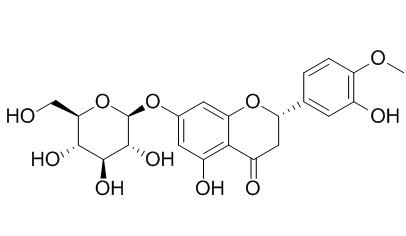Hesperetin 7-O-glucoside
Hesperetin 7-O-glucoside and prunin are direct precursors of naringin and neohesperidin, respectively, in C. aurantium. Hesperetin 7-O-glucoside shows inhibition of human HMG-CoA reductase, it also exhibits effective inhibition of the growth of Helicobacter pylori. Hesperetin 7-O-glucoside can reduce blood pressure in healthy volunteers.
Inquire / Order:
manager@chemfaces.com
Technical Inquiries:
service@chemfaces.com
Tel:
+86-27-84237783
Fax:
+86-27-84254680
Address:
1 Building, No. 83, CheCheng Rd., Wuhan Economic and Technological Development Zone, Wuhan, Hubei 430056, PRC
Providing storage is as stated on the product vial and the vial is kept tightly sealed, the product can be stored for up to
24 months(2-8C).
Wherever possible, you should prepare and use solutions on the same day. However, if you need to make up stock solutions in advance, we recommend that you store the solution as aliquots in tightly sealed vials at -20C. Generally, these will be useable for up to two weeks. Before use, and prior to opening the vial we recommend that you allow your product to equilibrate to room temperature for at least 1 hour.
Need more advice on solubility, usage and handling? Please email to: service@chemfaces.com
The packaging of the product may have turned upside down during transportation, resulting in the natural compounds adhering to the neck or cap of the vial. take the vial out of its packaging and gently shake to let the compounds fall to the bottom of the vial. for liquid products, centrifuge at 200-500 RPM to gather the liquid at the bottom of the vial. try to avoid loss or contamination during handling.
Journal of Third Military Medical University2019, 41(2):110-115
Biochem Biophys Res Commun.2020, 522(4):1052-1058
China Pharmacy2015, 26(27)
NanoBioScience2024, v13:3:115.
Pathol Res Pract.2024, :260:155445.
J Sep Sci.2018, 41(7):1682-1690
Int J Mol Sci. 2014, 15(5):8443-57
J Appl Biol Chem2021, 64(3):245-251.
Molecules.2018, 23(2)
Pharmaceuticals (Basel).2024, 17(4):462.
Related and Featured Products
Food Chem. 2012 Dec 15;135(4):2253-9.
Enzymatic bioconversion of citrus hesperidin by Aspergillus sojae naringinase: enhanced solubility of hesperetin-7-O-glucoside with in vitro inhibition of human intestinal maltase, HMG-CoA reductase, and growth of Helicobacter pylori.[Pubmed:
22980799]
METHODS AND RESULTS:
Hesperetin 7-O-glucoside (Hes-7-G) was produced by the enzymatic conversion of hesperidin by Aspergillus sojae naringinase due to the removal of the terminal rhamnose.Extracts from orange juice and peel containing the hesperidin were so treated by this enzyme that the hesperidin could also be converted to Hesperetin 7-O-glucoside . The solubility of Hesperetin 7-O-glucoside in 10% ethanol was enhanced 55- and 88-fold over those of hesperidin and hesperetin, respectively, which may make Hesperetin 7-O-glucoside more bioavailable. Hesperetin 7-O-glucoside was 1.7- and 2.4-fold better than hesperidin and hesperetin, respectively, in the inhibition of human intestinal maltase. Hesperetin 7-O-glucoside was more potent by 2- and 4-fold than hesperidin in the inhibition of human HMG-CoA reductase. Additionally, Hesperetin 7-O-glucoside exhibited more effective inhibition of the growth of Helicobacter pylori than hesperetin, while its effectiveness was similar to that of hesperidin.
CONCLUSIONS:
Therefore, the results suggest that bioconverted Hesperetin 7-O-glucoside is more effective and bioavailable than hesperidin, as it has enhanced inhibitory and solubility properties.
Mol Nutr Food Res. 2015 May 27.
Gastrointestinal absorption and metabolism of hesperetin-7-O-rutinoside and hesperetin-7-O-glucoside in healthy humans.[Pubmed:
26018925]
Hesperetin 7-O-glucoside (hesperidin) reduces blood pressure in healthy volunteers but its intestinal absorption and metabolism are not fully understood. Therefore, we aimed to determine sites of absorption and metabolism of dietary flavanone glycosides in humans.
METHODS AND RESULTS:
Using a single blind, randomized crossover design, we perfused equimolar amounts of Hesperetin 7-O-glucoside and Hesperetin 7-O-glucoside directly into the proximal jejunum of healthy volunteers. We assessed the appearance of metabolites in the perfusate, blood and urine, to determine the sites of metabolism and excretion, and compared this to oral administration. Theglucoside was rapidly hydrolysed by brush border enzymes without any contribution from pancreatic, stomach or other secreted enzymes, or from bacterial enzymes. Only ∼3% of the dose was recovered intact in the perfusate, indicating high absorption. A proportion was effluxed directly back into the perfused segment mainly in the form of hesperetin-3'-O-sulfate. In contrast, very little hydrolysis or absorption of Hesperetin 7-O-glucoside was observed with ∼80% recovered in the perfusate, no hesperetin metabolites were detected in blood and only traces were excreted in urine.
CONCLUSIONS:
The data elucidate the pathways of metabolism of dietary hesperidin in vivo and will facilitate better design of mechanistic studies both in vivo and in vitro. The trial was registered at Medical Faculty of the University of Tübingen.
Journal of Agricultural & Food Chemistry, 1993, 41(11):1920-1924.
Hesperetin 7-O-glucoside and prunin in Citrus species (C. aurantium and C. paradisi). A study of their quantitative distribution in immature fruits and as immediate precursors of neohesperidin and naringin in C. aurantium.[Reference:
WebLink]
METHODS AND RESULTS:
The flavanone glucosides prunin (naringenin 7-O-glucoside) and Hesperetin 7-O-glucoside were isolated and identified in the immature fruits of Citrus aurantium. Only prunin was identified in Citrus paradisi. This is the first study concerned with the isolation of Hesperetin 7-O-glucoside from Citrus tissues and with the quantitative distribution of both flavanone glucosides during the development of C. aurantium fruits. Both reach maximum concentration during the first stages of growth, gradually decreasing until the fruits reach maximum development. The total content per fruit of both glucosides is at its greatest at the end of the logarithmic phase of fruit development. The total content per fruit falls sharply when the corresponding neohesperidosides, naringin and neohesperidin, the most abundant flavanone glycosides in C. aurantium, reach their maximum levels.
CONCLUSIONS:
These data and the demonstration of the capacity of glucosyltransferase from cell-free extracts of C. aurantium tissues to glucosylate naringenin and hesperetin suggest that prunin and Hesperetin 7-O-glucoside are direct precursors of naringin and neohesperidin, respectively, in C. aurantium.



